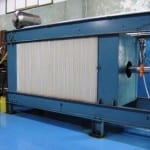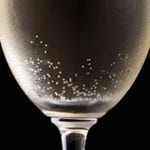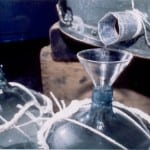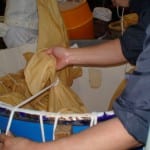Trend or sporadic anomaly? You make the call.
 Trends can be difficult to identify, at least real ones. And people are always looking for them; folks are always asking about what is new in the sake world, and what trends are appearing. But amongst the plethora of new ideas and styles of sake that appear from time to time, how many are really a trend and how many are just an anomaly?
Trends can be difficult to identify, at least real ones. And people are always looking for them; folks are always asking about what is new in the sake world, and what trends are appearing. But amongst the plethora of new ideas and styles of sake that appear from time to time, how many are really a trend and how many are just an anomaly?
A useful observation to which I regularly refer to is this: there are about 1200 licensed sake breweries in Japan. A very rough estimate is that there is an average of about 20 products from each one. Some have three, others have 50, but the average is probably around 20 or so. Doing that math (1200 x 2) yields 24,000 products, so let’s round that up to 25,000 sake items on the Japanese sake market.
If 25 products of a particularly bent appear on the market over the span of a year or two, that is one tenth of one percent of all that are out there. Is that a trend? Hardly. But folks do like to latch on to things and read a lot into them. And, admittedly, there are actual trends that do appear from time to time, so the tendency to look for them is not at all misplaced.
One such development that has manifested in the sake world over the decade or so is “slightly gassy sake.” As cumbersome as that wording may be, it is accurately descriptive, and there is no real or official term for it. There are currently just a handful of these sake out there, but they are very visible products from extremely popular brewers, and as such attract a decent amount of attention. While probably not enough to constitute a trend, you’ll want to know about them and why and how they are as they are.
“Slightly gassy sake” is, just like it sounds, sake with a very small amount of carbon dioxide remaining in it.
 Note, we are not talking about full-on sparkling sake, which is a completely different animal altogether and is much closer to being a full-fledged trend, replete with proper nomenclature and a sector of the industry that actively promotes it. Such sparkling sake is made by creating more gas in the bottle via secondary fermentation, although there are other methods as well. “Slightly gassy sake,” or SGS for the remainder of this article, contains a small amount of gas that remains from the original fermentation, but that’s all. (We will look at the category of sparkling sake in a future feature.)
Note, we are not talking about full-on sparkling sake, which is a completely different animal altogether and is much closer to being a full-fledged trend, replete with proper nomenclature and a sector of the industry that actively promotes it. Such sparkling sake is made by creating more gas in the bottle via secondary fermentation, although there are other methods as well. “Slightly gassy sake,” or SGS for the remainder of this article, contains a small amount of gas that remains from the original fermentation, but that’s all. (We will look at the category of sparkling sake in a future feature.)
Although not at all official, the term “gasu-khan” is often used to refer to what I am calling SGS here. And while full-on sparkling sake very often has a lower alcohol content, as low as six to eight percent, SGS is usually the full 16 percent or so.
SGS is made by pressing the sake, and getting it to the bottle as soon as possible, and with as little manhandling as possible. This lets just  a bit of the copious amounts of carbon dioxide that was there during fermentation to remain in the sake. The gas does not have a chance to escape or be blown off by sloshing it through pipes, pumps and processing on the way to the bottle. Note, once it is in the bottle, pasteurization will not make it go away, so SGS is not at all limited to namazake.
a bit of the copious amounts of carbon dioxide that was there during fermentation to remain in the sake. The gas does not have a chance to escape or be blown off by sloshing it through pipes, pumps and processing on the way to the bottle. Note, once it is in the bottle, pasteurization will not make it go away, so SGS is not at all limited to namazake.
While everyone does it at least a little bit differently, some brewers will bring the equipment used to press and bottle the sake right up to the tank to minimize the potential for lost gas. There are even a couple of proprietary methods out there as well.
In most of these products the effect is subtle, although in some it may be more overt than others. Flavor and aromas are not affected, and sometimes you may be left wondering if any gas was even there in the first place.
Note, there is nothing about this on the labels of these products, at least not that I have seen. They don’t really promote this aspect of it; it’s just kind of there. It certainly gets talked about, but more of as a highlight to an already good product.
The brewers that produce these products usually only create one or two products with this characteristic. There are exceptions, like Kaze no Mori (Nara) that makes a lineup of ‘em, but that is even less common.
Other well-known and popular producers that make one or more SGS products include Aramasa (Akita), Kamoshibito Kuheiji (Aichi), and Azumi Ichi (Saga). Recently I discovered another, Junsei which is made by Fukunishiki (Hyogo). There are others, of course, but just a handful.
What’s the point? The small amount of fine-grained gas can add a fresh touch, a new kind of appeal, and a nice accent. Most people like it, I guess, but I will admit that I find it to be a bit distracting. Not hugely, mind you, just a bit. Given the choice, most of the time I would prefer it to not be in my sake. For a few sips, or for one glass? Yeah. Fun. For a session? Jama. It stands in the way of full enjoyment.
So in truth, the expression “not a fan” might apply here. But that is just me! Many folks seem to enjoy it.
 Will this kind of thing continue to grow? Will more and more products with this SGS character appear on the market? In my opinion, no. I think that the ones that are out there will continue to do well, but I do not see many more breweries jumping on that bandwagon. It can be fun and tasty for sure, but the small gassy touch does not unequivocally improve the product, and it does not add tangible value. It is also an added hassle for the producer.
Will this kind of thing continue to grow? Will more and more products with this SGS character appear on the market? In my opinion, no. I think that the ones that are out there will continue to do well, but I do not see many more breweries jumping on that bandwagon. It can be fun and tasty for sure, but the small gassy touch does not unequivocally improve the product, and it does not add tangible value. It is also an added hassle for the producer.
Yet it is an appealing and welcome alternative style that is enjoyed by many sake aficionados, so we may in fact see at least some continued growth, even if it never becomes a bona fide trend.
Note, this article originally appeared in the November 1, 2019 edition of Sake Industry News. If you are interested in a slightly deeper dive into the sake world than this newsletter usually provides, please consider subscribing.
 Know more. Appreciate more.
Know more. Appreciate more.
Interested in learning more about sake, and the industry in Japan that makes it? Subscribe to Sake Industry News, a twice-monthly newsletter covering news from within the sake industry in Japan. Learn more and read a few sample issues here.







